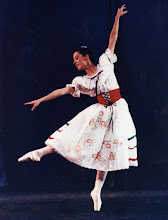
Dancers are often in pain. It’s a fact of life when you spend hours everyday pushing your muscles and bones beyond their usual limits. Sometimes running through a particular piece of choreography several times will cause muscles in a certain area to seize up. I remember longing for the day when I could be a “normal” person again: someone who would wake up free from pain and go about my day without taxing my body too much. Little did I know that my days would never morph into normality as I’d hoped, even after I stopped dancing.
Now I spend my days as a “normal” person, but it’s anything but the normal I dreamed about during my dancing days. As an employee at a bank, I work primarily at a computer. Any movement I make is one I force upon myself to take a break and get up and walk around. Unfortunately, my body has never really recovered from the abuse it took dancing. I’d like to do some research one day on retired ballet dancers and find out how many suffer from pain. Yesterday I read an article about Darcey Bussell; after being retired from dancing for two years she only exercises 45 minutes a week! She is determined to be a normal person, too. But back to my point…pain. How do dancers get relief from pain?
There are many things you can do to find relief—several of which I’ve tried. I can tell you what worked for me and then you can add comments to let us know what worked for you.
1. Chiropractic – Back when I was dancing, chiropractors were really considered alternative medicine. Today they have earned a more respectable place in medicine, and many primary care physicians refer patients to chiropractors. I’ve found that going once a month has been a good way to keep myself in alignment and to keep severe back pain at bay.
2. Acupuncture – I have a good friend from China who is an acupuncturist and I’ve seen her several times for back pain, ankle pain, neck pain, tennis elbow, depression, and what have you. She claims she can treat pretty much anything that ails you, and I don’t doubt it. Acupuncture can be expensive, and many insurance plans still don’t cover treatments. My acupuncturist actually doesn’t deal with insurance companies, so that makes it really hard for me to see her instead of a chiropractor, although sometimes I think acupuncture once a month would be ideal.
3. Massage – My healthcare plan allows me to see my chiropractor , who also employs massage therapists, and I can get an adjustment and a 30 minute massage all included in my $25 copay. You really can’t beat that, and the massage therapists there are wonderful. They target the areas where I’ve been experiencing the most pain lately. You have to feel comfortable telling them when they are pressing too hard or not hard enough. They can’t know unless you communicate with them, so don’t be afraid. Usually they are too gentle and I feel I could fall asleep since I’m so relaxed. This past month the girl was very intense and I was biting my tongue to keep from yelling out in pain. When I told her it was too much, she asked me if it was actually painful or just uncomfortable. I think that’s the way you can tell if it’s helping you or not: if it’s uncomfortable, it’s probably just right. I was actually in pain (with bruises to prove the point the next day), so she went a little lighter on the pressure after that.
4. Yoga – Sometimes just meditation and gentle stretching can relieve stress and tension. Using gravity to gently stretch out tight muscles while concentrating on your breathing can be a winning combination. There’s a lot to be said for meditation and pain, too.
5. Hot baths – Using Epsom salts in a nice, hot bath can be relaxing to tired muscles, especially at the end of a long day of dancing. If you’re pretty sure you’re going to be sore tomorrow, taking a hot bath tonight can help a lot. I like using REV for athletes. It’s a salt you can sit in for 15 minutes and it’s very helpful.
Does anyone else have ideas for helping relieve pain? Please leave a comment!












